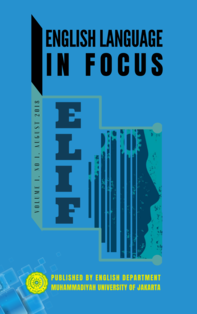Using Graphic Organizer to Improve Students’ Speaking skill
DOI:
https://doi.org/10.24853/elif.1.1.55-64Keywords:
Graphic Organizer, media, speakingAbstract
The purpose of this study was to determine whether Graphic Organizer has a significant effect on students' ability to speak. This study used the VIII.F students of Al-Azhar 12 Junior High School Rawamangun as the research sample. This class consists of 22 students. To choose the sample, the writer used a simple random sampling technique. From the population. The method used in this study was quantitative and the design used was a pre-experimental study with the technique of one group pre and post-test design. The instrument used in this study was oral tests. Then for that reason, the writer used the Weighting Table from Adam and Frith so that the measurement could be more accurate. The result of this research explains that students’ pre-test score is 72,36 and the post-test score is 81,45. The result of statistical hypothesis found out that the level of significance is higher than 0.000 < 0.005. This means H0 (Null Hypothesis) is rejected and H1 (Alternative Hypothesis) is accepted. Which means using the media Graphic Organizer is effective to improve students’ speaking skill.References
Brown, H. D. (2004). Language Assessment Principles and Classroom Practices. San Fransisco: Longman.
Ciascai, L. (2009). Using Graphic Organizers in Intercultural Education. Acta Didactica Napocensia, 2(1), 9–18.
Harmer, J. (2001). The Practice of English Language Teaching. Great Britain: Pearson Education Limited.
Hong Kong Curriculum Development Institute. (2001). The Use of Graphic Organizers to Enhance Thinking Skills in the Learning of Economics. Hong Kong: The Government Printer.
Irwin-DeVitis, L., Bromley, K. D., & Modlo, M. (1999). 50 Graphic Organizers for Reading, Writing & More. City of Jefferson: Scholastic Professional Books.
Kayi, H. (2006). Kayi - Teaching Speaking: Activities to Promote Speaking in a Second Language (TESL/TEFL). The Internet TESL Journal, 7(11). Retrieved from http://iteslj.org/
Manoli, P., & Papadopoulou, M. (2012). Graphic Organizers as a Reading Strategy: Research Findings and Issues. Creative Education, 03(03), 348–356. https://doi.org/10.4236/ce.2012.33055
McKnight, K. S. (2013). The Elementary Teacher’s Big Book of Graphic Organizers, K-5: 100+ Ready-to-Use Organizers That Help Kids Learn Language Arts, Science, Social Studies, and More. New Jersey: Jossey-Bass.
Nikolai, A. (2010). Advantages & Disadvantages of a Graphic Organizer | The Classroom. Retrieved from https://www.theclassroom.com/advantages-disadvantages-graphic-organizer-5522538.html
Pesce, C. (2017). 8 Ways to Use Graphic Organizers in Your ESL Class. Retrievedfrom https://busyteacher.org/13540-how-to-use-graphic-organizers-esl-class-8-ways.html
Qureshi, A. I. (2012). The impoertance of Speaking Skills for EFL Learners. Pakistan: Alama Iqbal Open University.
Rice-Johnston, W. (2008). Language: A Definition from First Principles - Three Grand Over the Truckstop. England: De Montfort University
Richards, J. C. (2008). Teaching Listening and Speaking: From Theory to Practice. New York: Cambridge University Press.
Thornbury, S. (2005). How to Teach Speaking. England: Pearson Educational Limited.
Ur, P. (2000). A course in English Language Teaching. Cambridge: Cambridge University Press.
Downloads
Published
Issue
Section
License
Authors who publish with this journal agree to the following terms:
- Authors retain copyright and grant the journal right of first publication with the work simultaneously licensed under a Creative Commons Attribution License that allows others to share the work with an acknowledgment of the work's authorship and initial publication in this journal.
- Authors can enter into separate, additional contractual arrangements for the non-exclusive distribution of the journal's published version of the work (e.g., post it to an institutional repository or publish it in a book), with an acknowledgment of its initial publication in this journal.
- Authors are permitted and encouraged to post their work online (e.g., in institutional repositories or on their website) before and during the submission process, as it can lead to productive exchanges, as well as earlier and greater citation of published work (See The Effect of Open Access).

